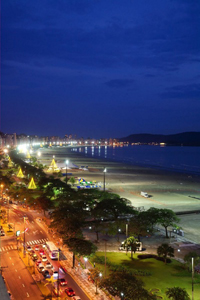Brazil and S&lde;o Paulo, some quick facts

- Brazil is the world’s largest country in the tropics occupying an area of 8.511.965 square km. In general it is the world’s fifth country in size. It has magnificent beaches, enormous rain forests and vast plains. It is estimated that Brazil contains greater biodiversity than any other country.
- In population Brazil is the sixth country in the world, after China, India, the United States, Indonesia and the Russian Federation. The population is highly diverse. The majority of people have ancestors in more than one of the three main groups: white Europeans (mostly Portuguese); black Africans (mainly from the west of the continent); and the original indigenous Indian population. Besides that, Brazil has the world’s second biggest black population, after Nigeria, the largest number of Japanese ancestry outside Japan and more people of Lebanese or Syrian extraction than the combined populations of Lebanon and Syria. Moreover Brazil has an fast growing (native) Indian population of about than 450.000 of more than 200 tribes. According to the National Foundation for the Indian in the Brazilian Amazon there are more than 60 'uncontacted' Indian groups living in complete isolation from the outside world. Government policy is to avoid contact with such groups unless they are in extreme danger.
- Portuguese is the official language of Brazil. Except for the languages spoken by Indian tribes living in remote reservations, Portuguese is the only language of daily life. Brazil is the only Portuguese-speaking country in South America.

- Brazil is the world's largest exporter of sugar, coffee, orange juice, soya, beef, tobacco and chicken. In terms of agriculture the Financial Times describes the country as 'a powerhouse whose size and efficiency few competitors can match'.
- Against a backdrop of rising concerns about climate change and declining oil reserves, Brazil has become a pioneer in the production of ethanol (produced from sugarcane) and other biofuels. More than three-quarters of the automobiles sold in Brazil have flex-fuel engines, capable of running on petrol, ethanol, or a mixture of the two. Biofuel can be produced from castor beans, oil palms, sunflowers, babaçu nuts, peanuts, jatropha and soya. Brazil anticipates that it will be producing biofuel at a rate of 1 billion litres per year by the end of 2007.
- Brazil has the only source of synchrotron light, which permits the study of atoms and molecules, in the Southern Hemisphere. The equipment – developed, built and operated entirely by Brazilians – belongs to the National Synchrotron Light Laboratory in Campinas, São Paulo state.
- São Paulo is Brazil’s megalopolis of rich cultural diversity with great museums, dining and nightlife. São Paulo is the country’s economic capital and pulsing heart.
- São Paulo, in the south-east of the country, is the biggest and most populous city in the Southern Hemisphere. The population of the city proper is around 11 million, and the adjacent metropolitan areas are home to a further 18 million. The urban region as a whole is therefore the second most populous in the world, after Tokyo.
- People from the city of São Paulo are known as paulistanos, while paulistas designates anyone from the whole of São Paulo state, including the paulistanos. The city's Latin motto is Non ducor, duco, which translates as 'I am not led, I lead'. A famous nickname for the city is 'Sampa'. São Paulo is also known for its unreliable weather, the sheer size of its helicopter fleet, architecture and multitude of skyscrapers.

For more information about Brazil visit the page about Brazil of the Brazilean government or, of course, wikipedia. Or for more information about São Paulo and the State of São Paulo visit São Paulo's tourist-site or São Paulo according to wikipedia.










